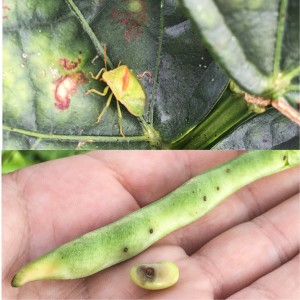The recent increase in stink bug population is causing concerns for local pea, bean, and soybean producers. Researchers have noticed an increase in secondary insect pests, such as stink bug species, over the last few years as farmers have reduced their use of broad spectrum herbicides. Entomologist throughout the southeast United States believe the Redbanded stink bug could become a potential problem for legume farmers. We have recently found the Redbanded stink bug (Piezodorus guildinii) as the dominant species in local crops. The implications of this are two-fold: 1) the species is especially damaging compared to other species and 2) control is much more difficult compared to others.
The Redbanded stink bug, like all stink bugs, has piercing and sucking mouth parts that allows it to penetrate stems, leaves, pods or seeds. In large numbers, stink bugs can cause major damage to host plants. In small numbers, they can do significant damage to fresh market crops such as peas, where consumers have a low tolerance for damage.
Soybean growers in Louisiana have been the epicenter of Redbanded stink bugs since about 2008. The dominance of Redbanded stinkbugs have led Extension specialists in Louisiana to recommend farmers plan to make three insecticide applications in early planted soybeans, and up to five applications in late planted. Roger Leonard, LSU AgCenter entomologist, said “The severity of damage the stink bug can inflict should not be underestimated. In many cases, if a grower skips or mistimes an application against an active infestation, he may not have any beans to harvest. And if he does, the damage can be so extensive the elevator won’t take them.”
Dr. Leonard also stated, “The Southern green and Green species of stink bugs have been very easy to control with pyrethroids at $3 or $4 per acre. The brown stink bugs are a bit more difficult to control, but a number of products can do a good job on them. It’s the red-banded stink bug that is much more difficult to control. Most pyrethroids used at high rates don’t provide consistent, effective control. It’s important to know the differences between the stink bug species because of differences in product efficacy.”
Entomologists have found significant yield losses unless treatments continue in the presence of insects through the R6 growth stages. If you want to manage for optimum seed quality, treatments must go through the R7 stage. Soybeans mature at R8. At the R7 growth stage, at least one pod per plant is brown and the plants are beginning to senesce.
We are just finding these increasing numbers and dominance of Red-banded stinkbugs locally, check back to www.flacrops.com for specific insecticide recommendations as the season progresses.
Posted by Sarah Chambers, Extension Intern


Very good synopsis of the seriousness and difficulties in managing this pest. Dr. Leanord was very accurate in segregating this legume pest from many others we have all dealt with in our careers. And Dr. Leonard has been in the field many years.
I learned the hard way after 29 years managing pests in soybeans in Louisiana, the original epicenter of the RBSB problem. Starting in 2001, when we first were introduced to this menace, everything we have always done and learned changed very quickly. It still is a major problem here in leguminous crops, but we manage it intensely and survived. But production costs do go way up, especially after mild winters in a sub-tropical climate.
Word of advice, during a mild winter, sweep leguminous winter weeds like clover and vetch surrounding intended crop areas. It will give you a heads up on potential additional input expenses before the legume crops are seeded.